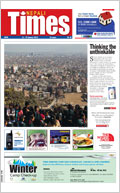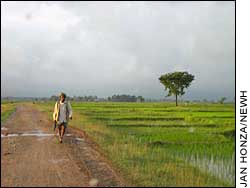 Arsenic often gets ignored, associated with out-of-date murder mysteries involving lace and country houses. But there is arsenic in the water in many parts of South Asia, and it could kill yet. Arsenic is an element found in rocks and sediments, can slowly poison humans when dissolved in drinking water. In the past drinking water in Bangladesh and West Bengal has been found to be contaminated with arsenic, but results from recent studies in Nepal's tarai are cause for concern.
Arsenic often gets ignored, associated with out-of-date murder mysteries involving lace and country houses. But there is arsenic in the water in many parts of South Asia, and it could kill yet. Arsenic is an element found in rocks and sediments, can slowly poison humans when dissolved in drinking water. In the past drinking water in Bangladesh and West Bengal has been found to be contaminated with arsenic, but results from recent studies in Nepal's tarai are cause for concern. Some 17,000 tube wells have so far been studied, and more than five percent of them have had arsenic concentrations over 50 parts per billion (ppb), the amount Nepal has set as its national guideline. Furthermore more than 25 percent are above 10 ppb, which is the guideline value set by the World Health Organisation (WHO). Kim Rud Adamsen and Anil Pokhrel, working at Nepal Water for Health (NEWAH), say that their organisation's mathematical models, with the government's 50 ppb as the maximum acceptable arsenic level, translate to 20, 000-40,000 deaths annually after 10 to 20 years of time. According to the mathematical model the number of deaths are only reduced by 50 percent, if the national guideline value is set to 50 ppb.

The arsenic problem hence becomes comparable to the problem of bacterial infection. It differs in that the bacterial problem is one that affects weaker people more seriously, while anybody could die from arsenic poisoning. Furthermore the problem of arsenic is a long-term effect whereas the bacterial problem is instant. According to the latest statistics 30000 pass away from the bacteriological problem.
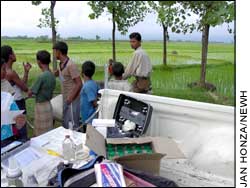 There are two kinds of arsenic poisoning: acute and chronic. Acute poisoning occurs in industrial locations, mines, and factories. In countries with lower levels of industrialisation such as Nepal, on the other hand, chronic poisoning is more common. Symptoms appear as darkening of skin colour and reddening of the eyes and other initial effects. These symptoms are visible depending upon the level of arsenic contamination in drinking water. Chronic poisoning leads to health problems such as cancer of the kidneys, liver, lungs, stomach and other internal organs which may appear only after 10 to 30 years, depending on the general health and diet of a person and the amount of arsenic uptake.
There are two kinds of arsenic poisoning: acute and chronic. Acute poisoning occurs in industrial locations, mines, and factories. In countries with lower levels of industrialisation such as Nepal, on the other hand, chronic poisoning is more common. Symptoms appear as darkening of skin colour and reddening of the eyes and other initial effects. These symptoms are visible depending upon the level of arsenic contamination in drinking water. Chronic poisoning leads to health problems such as cancer of the kidneys, liver, lungs, stomach and other internal organs which may appear only after 10 to 30 years, depending on the general health and diet of a person and the amount of arsenic uptake. The problem, say Adamsen and Pokhrel, is that studying arsenic contamination is very difficult. "We are studying very small amounts-a few parts per billion-and the equipment necessary for that is expensive. Apart from this we don't have enough financial resources on a national level to mitigate this burning problem which can later explode into serious effects for the tarai population of Nepal. Until now the testing is limited only to agency supported wells and does not account for the innumerable private wells. The mitigation plan for the nation should include these private wells. At the current stage it is not possible to adopt a guideline value in line to the WHO standard. The policy states that this guideline value will be revisited every year. These are part of the reasons the government set the national guideline value higher than the WHO standard. What this does, of course, is ignore the risk bracket between 10 and 50 ppb.
Arsenic research in Nepal began slowly in 1999 when the HMG's Department of Water Supply and Sanitation first began its surveying of tarai districts with the support of the WHO. Since then, the Nepal Red Cross Society has taken the lead with tests of more than ten thousand water samples. The National Arsenic Steering Committee, which includes NGOs, international and government organisations, was formed in 2001 to co-ordinate all arsenic research in Nepal, and the NGO Informal Committee also began to support the Steering Committee. Pokhrel says that NEWAH is in the process of building regional forums to interact and identify solutions around quality water supply including the arsenic dilemma.
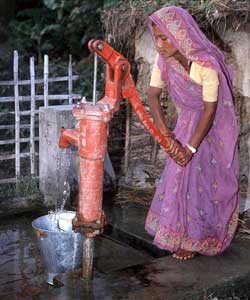 The tests to detect arsenic contamination in ground water are carried out either using field test kits or analysed at laboratories in Kathmandu. Most of the sector organisations are using field test kits as they are cheaper and the results are obtained instantly at the site. This also improves the necessary communication to the community in order to lower the arsenic uptake by the people in the remote tarai villages. Initially these kits were imported, but now a Nepali NGO named ENPHO, has also started making the kits locally. The laboratory tests are relatively expensive and the water samples have to be sent to Kathmandu.
The tests to detect arsenic contamination in ground water are carried out either using field test kits or analysed at laboratories in Kathmandu. Most of the sector organisations are using field test kits as they are cheaper and the results are obtained instantly at the site. This also improves the necessary communication to the community in order to lower the arsenic uptake by the people in the remote tarai villages. Initially these kits were imported, but now a Nepali NGO named ENPHO, has also started making the kits locally. The laboratory tests are relatively expensive and the water samples have to be sent to Kathmandu. There are an unknown number of tube wells in Nepal-probably more than 300,000-of which more than 17,000 samples have been tested. Approximately two-thirds of these tests have taken place in labs, so while statistical information was finally available, very little was done to inform communities around high-risk wells that their water was contaminated.
Though researchers admit that field testing is far less precise than tests conducted in the lab, they still support it. But researchers might have to rethink their testing strategy if the government can be persuaded by the other members of the Steering Committee to change the guideline value to the WHO-recommended 10 ppb. " In the longer run we don't want people consuming arsenic in the 10 ppb to 50 ppb bracket to be ignored," say Adamsen and Pokhrel.
Government officials explain their side of the problem. "We want to make sure that all the highly contaminated wells are closed before we bring the standard down to ten," says Nirmal Tandukar of the Department of Water Supply and Sanitation. His colleague at the DWSS, Amar Neku, adds, "Right now we don't have enough resources to bring the standard down to ten. The private sector might have enough money to work with this standard, but we don't. Our priority is to close all the seriously affected wells before we proceed. Of course, we too would like to ultimately bring down the standard to 10 ppb but we need to take things slowly." Currently, an estimated 500,000 people consume water with arsenic concentrations of over 50 ppb, and 26 million drink and cook with water that has over 10 ppb of arsenic.
The roots of the problem go back to the 1980's-the Decade of International Water Supply and Sanitation. As traditionally used dug-wells were easily microbiologically polluted, UNICEF, WHO and a host of other international organisations advised that tube wells be drilled to provide safer drinking water. Arsenic wasn't on anyone's mind, until large amounts were detected in drinking water in Bangladesh and West Bengal in 1986, and arsenic research began in those parts of the region. Over a decade later, in 1997, when some 90 percent of tube wells in Bangladesh had been tested and 20 percent of these closed due to high levels of arsenic contamination, water experts in Nepal decided it was time to look into the quality of water supply here.
It is difficult to explain the whys, wheres and hows of arsenic contamination in Nepal, and there are plenty of theories to choose from. Scientist and water expert Dipak Gyawali thinks delving into the causes can wait. "No one knows which theory is right. What's important is to find out which process contributes to arsenic contamination most." That may not be happening fast enough. Going by the data from the studies being conducted currently, the death toll is increasing, and will continue to do so at a much faster rate than the concentration of arsenic.
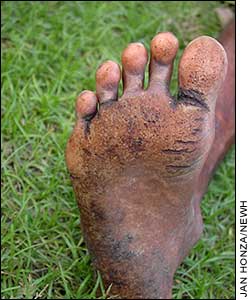 The cheapest way to remedy the problem is to stop using the water for drinking and cooking purposes in any well that is found to be contaminated and for example start harvesting rainwater for use instead. It is expensive to investigate contamination, and the costs to do so will only increase if the government decides to reduce the guideline value to 10 ppb. An added difficulty is that testing only one well in a locality is not an accurate measure of the arsenic contamination or lack thereof in neighbouring wells. Therefore all wells must be measured. Despite the difficulties, research teams are trying to survey all of Nepal's tube wells. Of the 17 tarai districts studied so far, Nawalparasi, Rautahat, Bara, Kailali and Parsa have the highest incidence of groundwater contaminated with arsenic.
The cheapest way to remedy the problem is to stop using the water for drinking and cooking purposes in any well that is found to be contaminated and for example start harvesting rainwater for use instead. It is expensive to investigate contamination, and the costs to do so will only increase if the government decides to reduce the guideline value to 10 ppb. An added difficulty is that testing only one well in a locality is not an accurate measure of the arsenic contamination or lack thereof in neighbouring wells. Therefore all wells must be measured. Despite the difficulties, research teams are trying to survey all of Nepal's tube wells. Of the 17 tarai districts studied so far, Nawalparasi, Rautahat, Bara, Kailali and Parsa have the highest incidence of groundwater contaminated with arsenic. 
